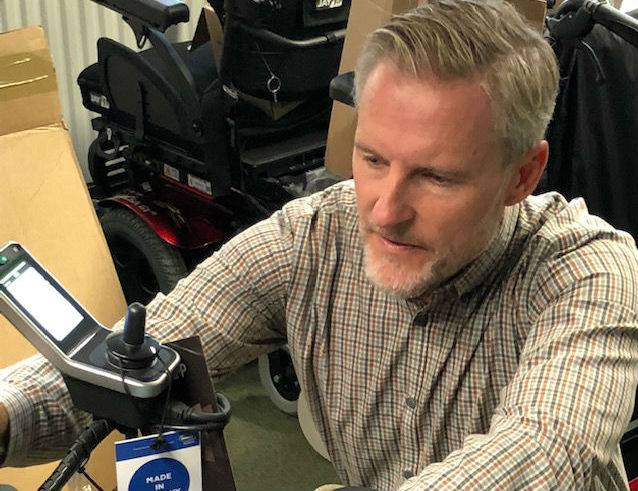Engineer Dean Hobson is using the latest technology to transform the lives of people throughout the region.
Dean, a specialist rehabilitation engineer at Bradford Teaching Hospitals NHS Foundation Trust, is the only person in the district with the knowledge needed to design and construct hi-tech wheelchairs for residents with some of the most challenging health conditions.
Standard NHS wheelchairs can weigh up to 20kg and are unsuitable for people with complex health needs. But, thanks to Dean and colleagues at the Trust’s Wheelchair Services department, Bradford residents can now access tailor-made state-of-the-art electric chairs.
“The right wheelchair can transform someone’s life,” said Dean, “and I will work with each person and the wheelchair companies to get the best results possible.
“It’s satisfying being able to help someone in a small way as there is no-one else in Bradford who does this.”
Wheelchairs have moved on considerably from the days of wrought-iron frames and rubber tyres, with some now featuring touchscreens to control movement, on-board computers and electrics which allow the chair to be turned through 360 degrees on its own axis for easier access.
Thanks to the skills he has developed during 12 years in the job, Dean is able to marry wheelchairs with the latest technology to meet very specific needs.
Best wheelchairs possible
“I don’t like to give in,” he said. “The technology is moving forward and the step changes are getting bigger all the time. Our job is to give people the best wheelchairs possible.”
Dean recently finished a chair for a teenage gaming fan which is operated by a Playstation controller, and has adapted others for patients with limited mobility which feature a touchscreen controlled by a joystick which needs just 10 grammes of pressure to operate.
The latest technology is also used to ensure each wheelchair provides the maximum level of comfort, with Dean and his colleagues using pressure mapping technology to examine patients’ seated posture and identify areas prone to pressure sores. The information they glean will then help identify the best type of cushion for them.
In some cases they will also use a hi-tech ‘beanbag’ to create a 3D model and help the seat manufacturers mould a cushion into the most comfortable shape.
“Everyone is different and we need to make sure each chair is the best it can be for each patient,” said Dean, who is a member of the Clinical Engineering team based at Bradford Royal Infirmary. “In the past we used plaster of Paris, but things have changed and we now aim to provide a really intimate fit.
“It’s not so much about comfort but to prevent pressure ulcers. The more surface area you can sit on, the better. The seat we use varies according to the disability and it’s all about being sat with a good posture.”
Around 6,000 wheelchair users are on the books of Wheelchair Services and Bradford Teaching Hospitals has made great strides in recent years to increase provision to them all.

